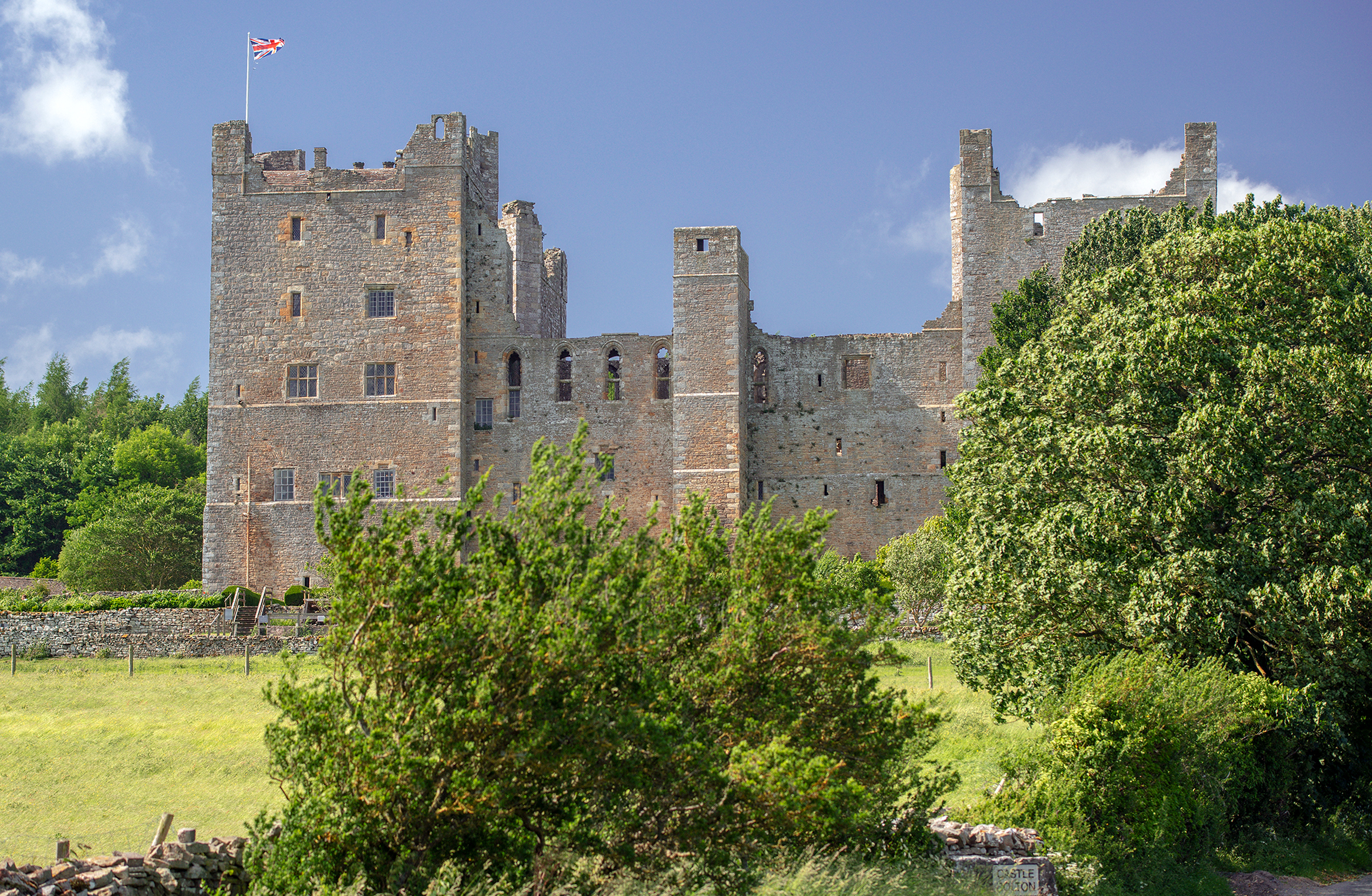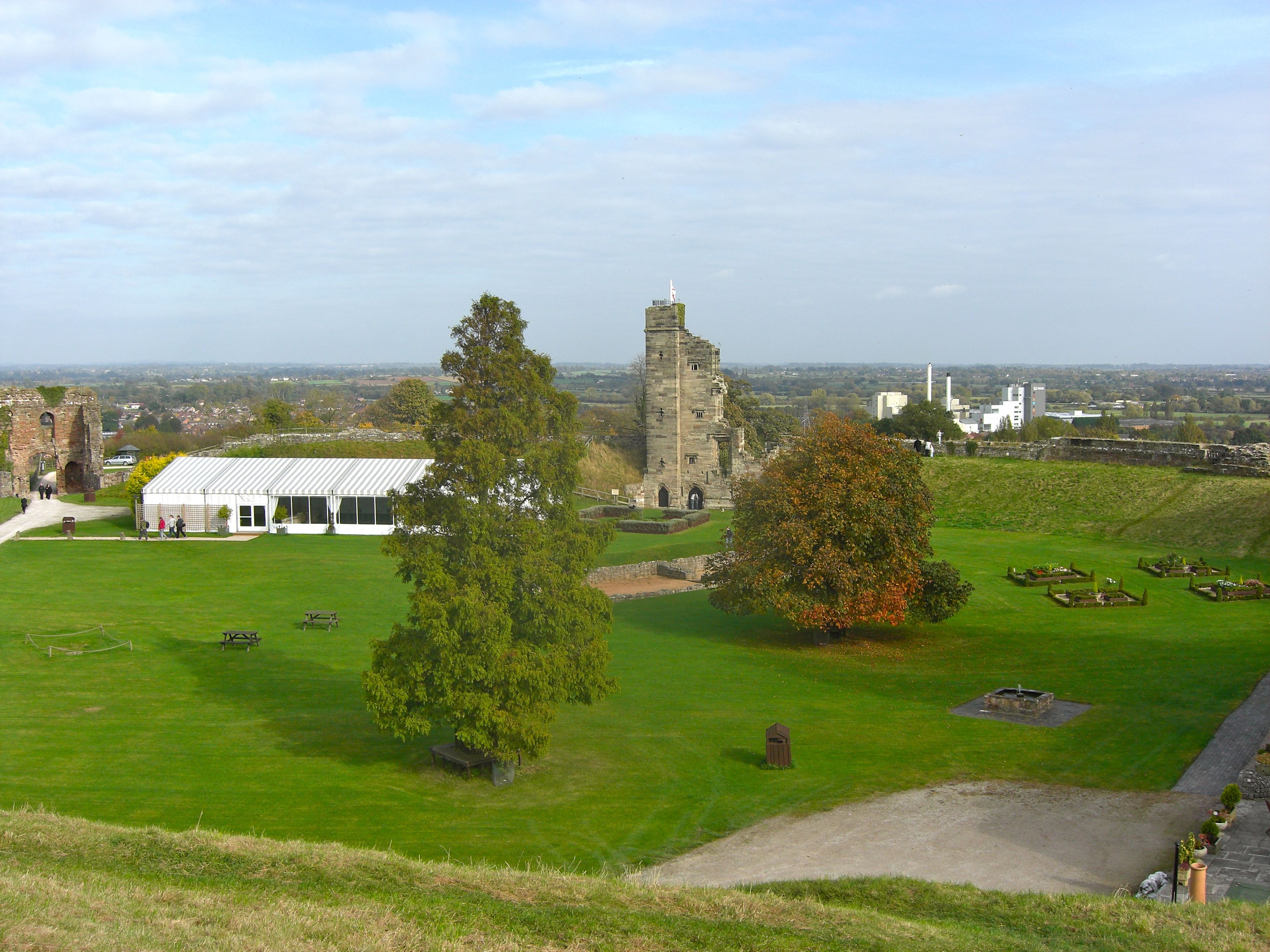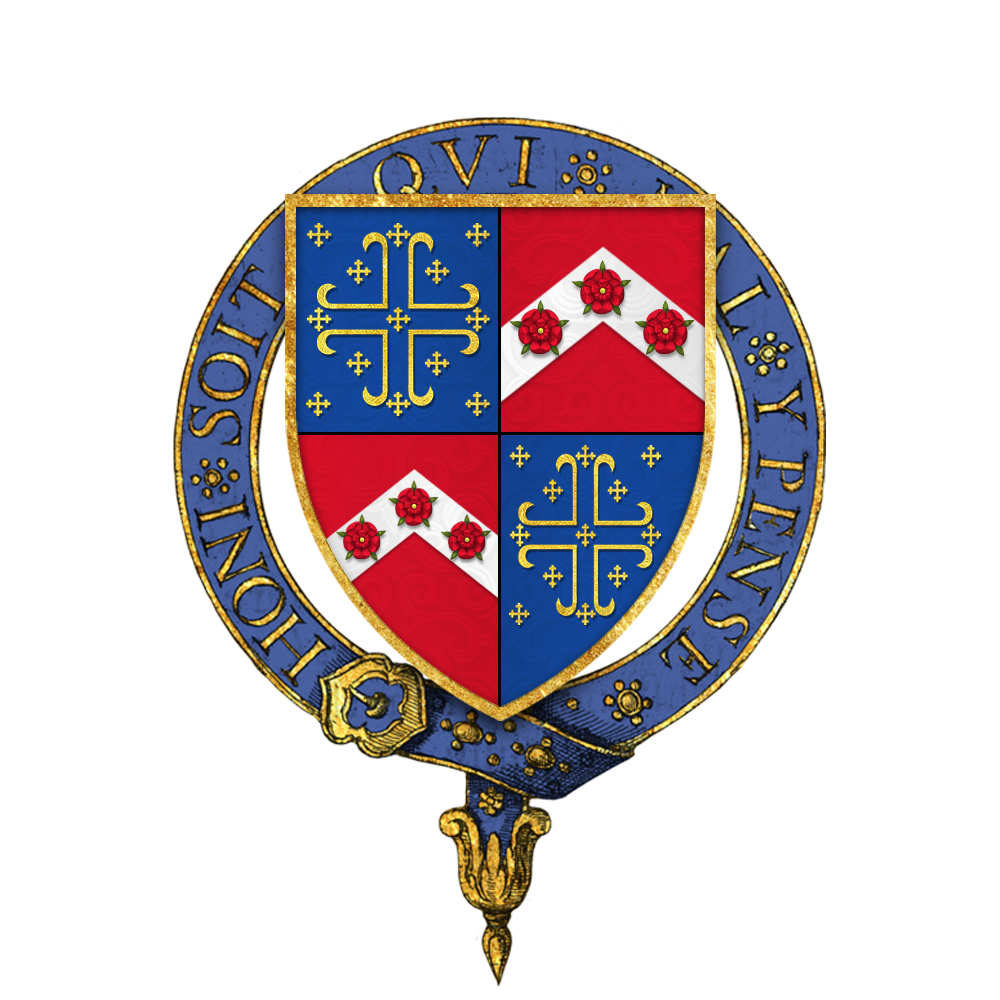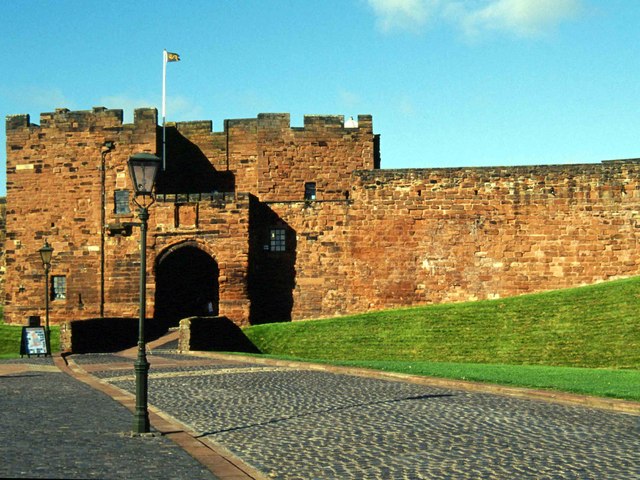|
Bolton Castle
Bolton Castle is a 14th-century castle located in Wensleydale, Yorkshire, England (). The nearby village of Castle Bolton takes its name from the castle. The castle is a Grade I listed building and a Scheduled Ancient Monument. The castle was damaged in the English Civil War, and “slighted” afterwards, but much of it survived. It has never been sold and is still in the ownership of the descendants of the Scrope family. History The castle was built between 1378 and 1399 by Richard, 1st Baron Scrope of Bolton, and is an example of a quadrangular castle. The licence to build it was granted in July 1379 and a contract with the mason John Lewyn was made in September 1378. Construction was reputed to cost 18,000 Marks. The 16th-century writer John Leland described 'An Astronomical Clock' in the courtyard and how smoke was conveyed from the hearth in the hall through tunnels. Bolton Castle was described by Sir Francis Knollys as having 'The highest walls of any house he had se ... [...More Info...] [...Related Items...] OR: [Wikipedia] [Google] [Baidu] |
Wensleydale
Wensleydale is the dale or upper valley of the River Ure on the east side of the Pennines, one of the Yorkshire Dales in North Yorkshire, England. It is one of only a few Yorkshire Dales not currently named after its principal river, but the older name, Yoredale, can still be seen on some maps and as the Yoredale Series of geological strata. The dale takes its name from the village of Wensley, once its market town. The valley is famous for its cheese, with the main commercial production at Hawes. Also famous are its ales from Theakston Brewery and Black Sheep Brewery in Masham. Most of the dale is within the Yorkshire Dales National Park. Part of lower Wensleydale, below East Witton, is within the Nidderdale Area of Outstanding Natural Beauty. Addlebrough, a fell, dominates the landscape of the upper dale, and Penhill at is prominent in the lower dale. History Wensleydale was the home of one of Yorkshire's most famous clans, the Metcalfes, after they emigrated ... [...More Info...] [...Related Items...] OR: [Wikipedia] [Google] [Baidu] |
Richard Le Scrope, 1st Baron Scrope Of Bolton
Richard le Scrope, 1st Baron Scrope of Bolton ( 1327 – 30 May 1403) was an English soldier and courtier, serving Richard II of England. He also fought under the Black Prince at the Battle of Crecy in 1346. Biography Richard le Scrope was a Knight of the Shire for Yorkshire in the parliament of 1364, and was summoned to the upper house as a baron by writ in 1371, when he was made Lord High Treasurer and Keeper of the Great Seal. In 1378 Lord Scrope became Lord Chancellor, a role in which he attempted to curb the extravagance of Richard II, but resigned in 1380 when the government collapsed due to military failures in France. After the turbulence of the Peasants' revolt, in which his successor was beheaded by the rebels, he took up the position again. He was finally deprived of office by King Richard for non-cooperation in 1382 and thereafter dedicated himself to the rebuilding of Bolton Castle. on his estates in Wensleydale in Yorkshire, for which he had been given licence to c ... [...More Info...] [...Related Items...] OR: [Wikipedia] [Google] [Baidu] |
Adam Sedbar, Abbot Of Jervaulx
Adam Sedbar or Sedbergh (c. 1502–1537) was the 23rd and last Abbot of Jervaulx Abbey in Wensleydale, Yorkshire. Biography Adam Sedbar had been elected abbot of the Cistercian abbey of Jervaulx in 1533 when Henry VIII introduced his plans for the Dissolution of the Monasteries. He was persuaded in 1536, somewhat reluctantly, to join in a Pilgrimage of Grace, together with other local abbots from Fountains, Bridlington and Guisborough Abbeys, in order to protest about the king's policies. The cause attracted a large number of followers, and urged on by a few fanatics, became increasingly militant. After a number of Yorkshire towns were attacked by the insurgents the King eventually decided, after some negotiation with their spokesman, to round up the ringleaders and charge them with treason . Sedbar sought sanctuary with John Scrope, 8th Baron Scrope of Bolton at his stronghold in Bolton Castle. When the King's Commissioners followed him there, Lord Scrope fled for his own s ... [...More Info...] [...Related Items...] OR: [Wikipedia] [Google] [Baidu] |
Tutbury Castle
Tutbury Castle is a largely ruined medieval castle at Tutbury, Staffordshire, England, in the ownership of the Duchy of Lancaster and hence currently of King Charles III. It is a Scheduled Ancient Monument. People who have stayed in the castle include Eleanor of Aquitaine and Mary, Queen of Scots, who was a prisoner there. History Norman origins Tutbury Castle became the headquarters of Henry de Ferrers and was the centre of the wapentake of Appletree, which included Duffield Frith. With his wife Bertha, he endowed Tutbury Priory with two manors in about 1080. It would seem that Tutbury at that time was a dependency of the Norman abbey of St Pierre‑sur‑Dives. Medieval era William de Ferrers, 3rd Earl of Derby joined a rebellion against Henry II in 1173–74 and Tutbury Castle was one of at least twenty castles belonging to the rebels that were slighted. The castle was "nearly destroyed" by Prince Edward in 1264 after the rebellion of Robert de Ferrers, 6th Earl of ... [...More Info...] [...Related Items...] OR: [Wikipedia] [Google] [Baidu] |
Scots Language
Scots ( endonym: ''Scots''; gd, Albais, ) is an Anglic language variety in the West Germanic language family, spoken in Scotland and parts of Ulster in the north of Ireland (where the local dialect is known as Ulster Scots). Most commonly spoken in the Scottish Lowlands, Northern Isles and northern Ulster, it is sometimes called Lowland Scots or Broad Scots to distinguish it from Scottish Gaelic, the Goidelic Celtic language that was historically restricted to most of the Scottish Highlands, the Hebrides and Galloway after the 16th century. Modern Scots is a sister language of Modern English, as the two diverged independently from the same source: Early Middle English (1150–1300). Scots is recognised as an indigenous language of Scotland, a regional or minority language of Europe, as well as a vulnerable language by UNESCO. In the 2011 Scottish Census, over 1.5 million people in Scotland reported being able to speak Scots. As there are no universally accept ... [...More Info...] [...Related Items...] OR: [Wikipedia] [Google] [Baidu] |
Mary Seton
Mary Seton (1542 – 1615) was a Scottish courtier and later a nun. She was one of the four attendants of Mary, Queen of Scots, known as the Four Marys. She was a sister at the Convent of Saint Pierre les Dames in Reims at the time of her death. Sent to France Mary Seton was the daughter of George Seton, 6th Lord Seton, and his second wife Marie Pieris or Pierres, a daughter of René Pierres, of Plessis Baudouin, and Antoinette d'Hommes. Marie Pierres was a lady-in-waiting to Mary of Guise, the wife of King James V of Scotland. The French Pierres family claimed to have descended from the Percy family of Northumberland. As a child, Mary Seton became a lady-in-waiting to the young Mary, Queen of Scots, along with three other girls of similar age and of a similar standing in Scots society. They were famously known as "The Four Marys": she and Mary Beaton, Mary Fleming and Mary Livingston. The Four Marys accompanied Queen Mary in France, where she later married the Dauphin, Francis ... [...More Info...] [...Related Items...] OR: [Wikipedia] [Google] [Baidu] |
Barnard Castle
Barnard Castle (, ) is a market town on the north bank of the River Tees, in County Durham, Northern England. The town is named after and built around a medieval castle ruin. The town's Bowes Museum's has an 18th-century Silver Swan automaton exhibit and paintings by Goya and El Greco. It sits on the opposite bank to Startforth and is south-west of the county town of Durham. Nearby towns include Bishop Auckland to the north-east, Darlington to the east and Richmond in North Yorkshire to the south-east. The largest employer is GlaxoSmithKline, with a manufacturing facility on the town's outskirts. History Before the Norman conquest the upper half of Teesdale had been combined into an Anglo-Norse estate which was centred upon the ancient village of Gainford and mortgaged to the Earls of Northumberland. The first Norman Bishop of Durham, Bishop Walcher, was murdered in 1080. This led to the surrounding country being attacked and laid waste by the Norman overlords. Further re ... [...More Info...] [...Related Items...] OR: [Wikipedia] [Google] [Baidu] |
British Library
The British Library is the national library of the United Kingdom and is one of the largest libraries in the world. It is estimated to contain between 170 and 200 million items from many countries. As a legal deposit library, the British Library receives copies of all books produced in the United Kingdom and Ireland, including a significant proportion of overseas titles distributed in the UK. The Library is a non-departmental public body sponsored by the Department for Digital, Culture, Media and Sport. The British Library is a major research library, with items in many languages and in many formats, both print and digital: books, manuscripts, journals, newspapers, magazines, sound and music recordings, videos, play-scripts, patents, databases, maps, stamps, prints, drawings. The Library's collections include around 14 million books, along with substantial holdings of manuscripts and items dating as far back as 2000 BC. The library maintains a programme for content acquis ... [...More Info...] [...Related Items...] OR: [Wikipedia] [Google] [Baidu] |
Francis Knollys (the Elder)
Sir Francis Knollys, KG of Rotherfield Greys, Oxfordshire (c. 1511 / c. 1514 – 19 July 1596) was an English courtier in the service of Henry VIII, Edward VI and Elizabeth I, and was a Member of Parliament for a number of constituencies. Early appointments Francis Knollys was born 1511, the elder son of Sir Robert Knollys (d. 1520/1521) and Lettice Peniston (d. 1557/1558), daughter of Sir Thomas Peniston of Hawridge, Buckinghamshire, henchman to Henry VIII. He appears to have received some education at Oxford. He married Catherine Carey, first cousin (as well as possible half-sister) of Queen Elizabeth I. Henry VIII extended to him the favour that he had shown to his father, and secured to him in fee the estate of Rotherfield Greys in 1538. Acts of Parliament in 1540–41 and in 1545–46 attested this grant, making his wife in the second act joint tenant with him. At the same time Francis became one of the gentlemen-pensioners at court, and in 1539 attended Anne of Cle ... [...More Info...] [...Related Items...] OR: [Wikipedia] [Google] [Baidu] |
Henry Scrope, 9th Baron Scrope Of Bolton
Henry Scrope, 9th Baron Scrope of Bolton, KG (c. 1534 – 13 June 1592) was the son and heir of John Scrope, 8th Baron Scrope of Bolton and Catherine Clifford, daughter of Henry Clifford, 1st Earl of Cumberland. Life Henry Scrope, a loyal supporter of Elizabeth I, was Marshal of the Army during the siege of Leith in 1559 which saw the end of the "Auld Alliance" between Scotland and France. He was appointed Warden of the West Marches and Captain of Carlisle from 1562 until the end of his life. In April 1568 Mary, Queen of Scots fled across the Solway Firth to England after losing the Battle of Langside. She landed at Workington, travelling from there to Cockermouth and from thence to Carlisle. Scrope was at court at the time, but hurried north with Sir Francis Knollys to take charge of her. After a brief imprisonment in Carlisle Castle, Mary was moved with a large retinue of servants to Lord Scrope's home in Yorkshire, Bolton Castle. Six months later she was moved on to ... [...More Info...] [...Related Items...] OR: [Wikipedia] [Google] [Baidu] |
Carlisle Castle
Carlisle Castle is a medieval stone keep castle that stands within the English city of Carlisle near the ruins of Hadrian's Wall. First built during the reign of William II in 1093 and rebuilt in stone under Henry I in 1122, the castle is over 900 years old and has been the scene of many historical episodes in British history. Given the proximity of Carlisle to the border between England and Scotland, it has been the centre of many wars and invasions. During the Jacobite Rising of 1745–6, Carlisle became the last English fortress to undergo a siege. The castle was listed as a Scheduled Ancient Monument on 7 August 1996. Today the property is managed by English Heritage and is open to the public. Until 2006, the castle was the administrative headquarters of the former King's Own Royal Border Regiment and until 2019 it was the county headquarters to the Duke of Lancaster's Regiment. A museum to the regiment is within the castle walls. History Carlisle Castle was first ... [...More Info...] [...Related Items...] OR: [Wikipedia] [Google] [Baidu] |
Queen Elizabeth I
Elizabeth I (7 September 153324 March 1603) was Queen of England and Ireland from 17 November 1558 until her death in 1603. Elizabeth was the last of the five House of Tudor monarchs and is sometimes referred to as the "Virgin Queen". Elizabeth was the daughter of Henry VIII and Anne Boleyn, his second wife, who was executed when Elizabeth was two years old. Anne's marriage to Henry was annulled, and Elizabeth was for a time declared illegitimate. Her half-brother Edward VI ruled until his death in 1553, bequeathing the crown to Lady Jane Grey and ignoring the claims of his two half-sisters, the Catholic Mary and the younger Elizabeth, in spite of statute law to the contrary. Edward's will was set aside and Mary became queen, deposing Lady Jane Grey. During Mary's reign, Elizabeth was imprisoned for nearly a year on suspicion of supporting Protestant rebels. Upon her half-sister's death in 1558, Elizabeth succeeded to the throne and set out to rule by good counsel. She ... [...More Info...] [...Related Items...] OR: [Wikipedia] [Google] [Baidu] |









